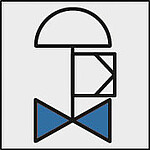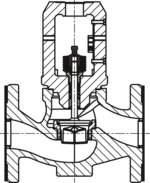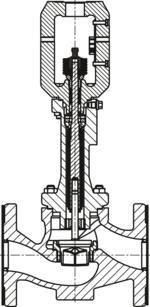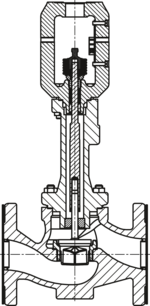Optimized Valve Sizing for Modular Linear Valves

With their flexible, modular design, our SAMSON control valves can be tailored to the specific control task, which allows them to meet even the most challenging requirements under severe operating conditions.
SAMSON can supply modular control valves with globe, angle and three-way bodies in all common pressure ratings and materials at short notice. The valves are designed in accordance with the ANSI, DIN or JIS standards and available with different flange types and welding ends.
Valve body
We have all common valve body styles and end connections in our product range, which can be combined in almost any way thanks to their modular design. No matter whether you are looking for a globe valve with screwed ends, a three-way valve with flanges or an angle valve with welding ends, SAMSON can supply you with the right valve body in the highest quality to meet your requirements.
The valves are available in a wide range of materials. To deliver the highest quality, the valve bodies are subjected to extensive inspection and testing before the valves are assembled. We perform inspections and tests depending on the valve material. The results are documented in a test report or inspection certificate depending on customer specifications.
Leakage
The targeted valve leakage depends on the plant requirements and the process medium used. Reducing leakage is not only relevant to hazardous substances. It applies to all media. While seat leakage is decisive to the proper functioning of the process, the control of fugitive emissions at the packing, bellows and flange is stipulated in various standards and regulations to reduce emissions and protect the environment.
The packings meet the fugitive emission requirements according to VDI 2440 and, as a result, fulfill the requirements of TA Luft (German technical instructions on air quality control). SAMSON's ISO packings are tested based on EN ISO 15848 and comply with the external leakage rates depending on the temperature, load and pressure even in continuous operation. The ANSI/FCI 91-1 standard and EPA (Environmental Protection Agency) specifications apply to ANSI valve versions.
Features
- Long service life
- Low level of friction and leakage, particularly with polished plug stem
- Improved sealing performance by using the combination of a special V-ring packing design and the medium pressure
- Standard: self-adjusting, spring-loaded V-ring packing made of PTFE-carbon
- Optional: adjustable, cavity-free packing in various materials (PTFE-silk, pure PTFE)
V-port plugs have three V-shaped ports. Their size varies depending on the valve size. The process medium in the valve flows through the V-shaped ports as soon as the plug is lifted out of the seat (i.e. the valve opens).
- Asymmetrical distribution of the orifice cross-section prevents plug vibration in critical operating conditions
- Minimized vibration through double-guided plug stem (guide bushing and seat guide)
- Insensitive to small dust particles
Flow dividers shorten the free jet exiting the vena contracta and accelerate the energy transfer in the mixing zone. As a result, noise emissions are reduced when handling gases and vapors.
- Used with gases and vapors
- Noise reduction for increased operational reliability
- Cost effective due to modular design
- Reinforced versions for high-pressure service
- No noticeable deviation from the characteristic (up to 80 % travel)
See data sheet for further details
T 8081 EN: Flow Dividers for Control Valves
A single-stage letdown at differential pressures up to 250 bar can be achieved using the Zero Travel 1 (ZT-1) trim.
- Flow-to-close (FTC) direction of flow
- Suitable for liquids, two-phase flows or gases
- Use in high-pressure letdown and critical steam applications
- Longer service life by separating the seating surface and throttling area
- Improved stability provided by an additional guide in the seat area
See data sheet for further details
T 8087 EN: Control Valves with Zero Travel 1 Trim
Perforated plugs are optimized to reduce noise levels. The process medium flows through the perforated plug and the jet stream is split into numerous smaller jets to ensure low-noise energy transfer to the surrounding medium.
- Flow-to-open (FTO) and flow-to-close (FTC) directions of flow possible
- Reduced vibration
- Suitable for critical medium states and steam service, particularly for operation in the wet steam region or with flashing conditions
See data sheet for further details
T 8086 EN: Valves with perforated plug
AC trims (AC-1, -2, -3 and -5) are optimized for the low-noise and low-wear pressure reduction of liquids. The AC trims ensure that the pressure is let down gradually across several throttling stages to prevent cavitation.
- Use at high pressure drops
- Additional plug guiding integrated into the seat and top guide bushing to ensure low-vibration operation of the valve
- Substantially longer service life
See data sheet for further details
T 8082 EN: Pneumatic Control Valves with AC-1 or AC-2 Trim
T 8083 EN: Pneumatic Control Valves with AC-3 or AC-5 Trim
The bonnet, which seals off the valve at the top, is used to mount the actuator or yoke. The standardized NAMUR rib located on the yoke allows easy, standardized attachment of a positioner or other valve accessories.
- Pressure-bearing part made of the same material used for the valve body
- Allows the actuator to be removed without having to dismantle the valve
Series 240 (up to DN 150):
- One single component for bonnet and yoke for a compact, rugged, lightweight construction
The bellows seal is installed in addition to the packing between the actuator and valve to seal off the plug stem.
- Strict fugitive emission requirements, e.g. as specified by TA Luft/ISO 15848
- Optional test connection and leakage indicator to monitor the sealing performance
- Long service life guaranteed by shorter stroking with multiple convolutions per millimeter
- Can be retrofitted and/or exchanged
The bellows seal also acts similar to an insulating section as it keeps the packing and actuator at a sufficient distance from the process medium to protect them against excessive temperatures.
The insulating section serves to keep the packing and actuator at a distance from the process medium.
- Extends the temperature range of the standard packing to between –196 and +450 °C/–320 and 842 °F
Cryogenic valves:
- Optional circulation inhibitor prevents the process medium from circulating inside the insulating section and protects the bonnet against extremely low temperatures (e.g. icing up).
Pneumatic actuators
SAMSON valves are preferably fitted with Type 3271 and Type 3277 Pneumatic Actuators, which have been proven in use over decades. Standardized interfaces (IEC 60534-6-1 and VDI/VDE 3847) as well as the direct attachment developed by SAMSON for Type 3277 Actuators allows actuators to be fitted with accessories, such as positioners, limit switches and solenoid valves. Through the modular design, the actuator and valve can be easily upgraded to achieve automated valves with short transit times suitable for use in safety-instrumented systems.
Automation
In the age of the Internet of Things, it is a matter of course that control valves are integrated into process control systems. Data on the control valve itself and diagnostic data are collected, saved, analyzed and transmitted to the process control system by digital field devices. Similarly, data can be forwarded from the process control system to the field devices. The field devices used in control valve engineering are usually positioners – in some cases also limit switches –, which are mounted on the control valve.
Positioners compare the set point issued by automation equipment (controller, control station, process control system) to the valve's position and supply the actuator with a corresponding output signal pressure (pst). SAMSON's digital positioners are also able to collect, analyze and transmit operating data.
- Mounting facilitated by the use of standardized interfaces
- Rugged, long-life metal housing
- Intuitive operation
- International explosion protection certificates
- Integration of many optional additional components into the positioner housing
- Automatic start-up
- Communication using HART®, PROFIBUS® or FOUNDATION™ fieldbus protocols
- EXPERTplus valve diagnostics
SAMSON's EXPERTplus valve diagnostics can detect faults and provide predictive, status-oriented maintenance recommendations for valves with pneumatic actuators. The full scope of diagnostic functions is completely integrated into the positioner. The numerous diagnostic functions allow faults to be pinpointed in control and on/off valves at an early stage.
- Compilation of diagnostic data
- Automatic start of diagnostic functions and tests
- Tests to monitor valve operation while the process is running
- Tests to analyze the condition of the entire control valve
- Status classification and condensed state according to NAMUR Recommendation NE 107
- Diagnostic data, test results and analyses saved in the positioner
- TROVIS SAFE series: on/off analysis with partial stroke test (PST)
This might also interest you
Self-operated regulators
SAM GUARD
MainChange
Valves
Commitment
Executive Board
Vocational training
Industry 4.0
SIL
SAM DISTRICT ENERGY
Solenoid valves
Lock-up valve
Headquarters
Actuators
Positioners
Sales offices
Volume boosters
Media
SAM TANK MANAGEMENT
Differential pressure meter
Supervisory Board
SAM LAN
Pilot valve
Automation
Service
Quick exhaust valves
SAM DIGITAL
Globe valves
Subsidiaries
Limit switch
Seminars
FDI
Hook-ups
Hydrogen
Conference
Valve accessories
Supply pressure regulators
Automation systems
Control valves
Careers
Digitalization




















